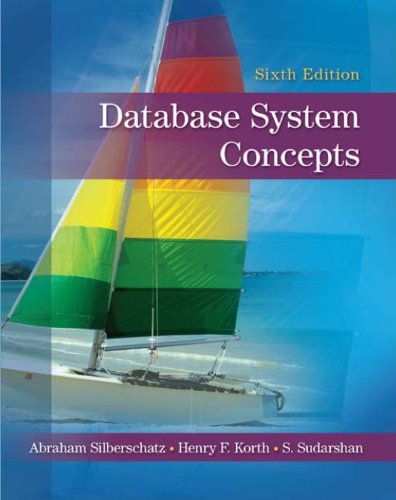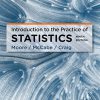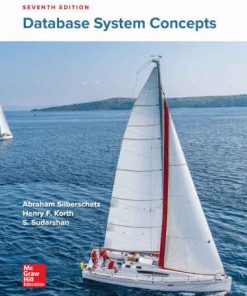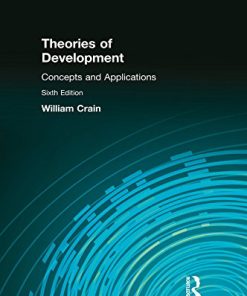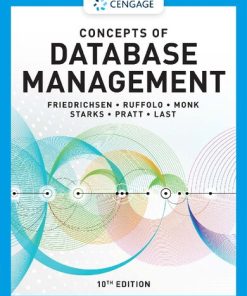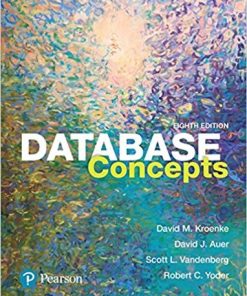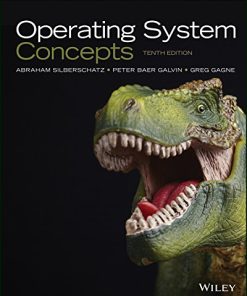Database System Concepts 6th Edition, (Ebook PDF)
$50.00 Original price was: $50.00.$24.50Current price is: $24.50.
Database System Concepts 6th Edition, (Ebook PDF) – Digital Instant Dowload.
Database System Concepts 6th Edition, (Ebook PDF) – Digital Instant Dowload.
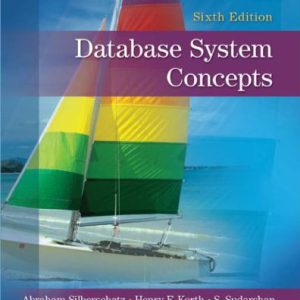
Product details:
- ISBN-10 : 0073523321
- ISBN-13 : 978-0073523323
- Author: Avi Silberschatz, Hank Korth, S. Sudarshan
Database System Concepts by Silberschatz, Korth and Sudarshan is now in its 6th edition and is one of the cornerstone texts of database education. It presents the fundamental concepts of database management in an intuitive manner geared toward allowing students to begin working with databases as quickly as possible.
The text is designed for a first course in databases at the junior/senior undergraduate level or the first year graduate level. It also contains additional material that can be used as supplements or as introductory material for an advanced course. Because the authors present concepts as intuitive descriptions, a familiarity with basic data structures, computer organization, and a high-level programming language are the only prerequisites. Important theoretical results are covered, but formal proofs are omitted. In place of proofs, figures and examples are used to suggest why a result is true.
Table contents:
Chapter 1 Introduction 1.1 Database System Applications 1 1.2 Database Systems versus File Systems 3 1.3 View of Data 5 1.4 Data Models 7 1.5 Database Languages 11 1.6 Database Users and Administrators 13 1.7 Transaction Management 15 1.8 Database System Structure 16 1.9 Application Architectures 18 1.10 History of Database Systems 18 1.11 Summary 21 Exercises 23 Bibliographical Notes 24 PART 1 DATA MODELS Chapter 2 Entity-Relationship Model 2.1 Basic Concepts 27 2.2 Constraints 33 2.3 Keys 35 2.4 Design Issues 37 2.5 Entity-Relationship Diagram 42 2.6 Weak Entity Sets 47 2.7 Extended E-R Features 49 2.8 Design of an E-R Database Schema 56 2.9 Reduction of an E-R Schema to Tables 62 2.10 The Unified Modeling Language UML 68 2.11 Summary 70 Exercises 72 Bibliographical Notes 77 Chapter 3 Relational Model 3.1 Structure of Relational Databases 79 3.2 The Relational Algebra 89 3.3 Extended Relational-Algebra Operations 103 3.4 Modification of the Database 111 3.5 Views 113 3.6 The Tuple Relational Calculus 118 3.7 The Domain Relational Calculus 122 3.8 Summary 126 Exercises 127 Bibliographical Notes 131 PART 2 RELATIONAL DATABASES Chapter 4 SQL 4.1 Background 135 4.2 Basic Structure 137 4.3 Set Operations 144 4.4 Aggregate Functions 146 4.5 Null Values 148 4.6 Nested Subqueries 149 4.7 Views 154 4.8 Complex Queries 155 4.9 Modification of the Database 157 4.10 Joined Relations 163 4.11 Data-Definition Language 168 4.12 Embedded SQL 172 4.13 Dynamic SQL 175 4.14 Other SQL Features 180 4.15 Summary 182 Exercises 183 Bibliographical Notes 186 Chapter 5 Other Relational Languages 5.1 Query-by-Example 189 5.2 Datalog 203 5.3 User Interfaces and Tools 217 5.4 Summary 219 Exercises 220 Bibliographical Notes 223 Chapter 6 Integrity and Security 6.1 Domain Constraints 225 6.2 Referential Integrity 227 6.3 Assertions 232 6.4 Triggers 233 6.5 Security and Authorization 238 6.6 Authorization in SQL 244 6.7 Encryption and Authentication 248 6.8 Summary 250 Exercises 252 Bibliographical Notes 254 Chapter 7 Relational-Database Design 7.1 First Normal Form 257 7.2 Pitfalls in Relational-Database Design 258 7.3 Functional Dependencies 260 7.4 Decomposition 271 7.5 Desirable Properties of Decomposition 275 7.6 Boyce-Codd Normal Form 279 7.7 Third Normal Form 284 7.8 Fourth Normal Form 289 7.9 More Normal Forms 293 7.10 Overall Database Design Process 293 7.11 Summary 297 Exercises 299 Bibliographical Notes 303 PART 3 OBJECT-BASED DATABASES AND XML Chapter 8 Object-Oriented Databases 8.1 Need for Complex Data Types 307 8.2 The Object-Oriented Data Model 308 8.3 Object-Oriented Languages 318 8.4 Persistent Programming Languages 318 8.5 Persistent C++ Systems 322 8.6 Persistent Java Systems 330 8.7 Summary 331 Exercises 332 Bibliographical Notes 333 Chapter 9 Object-Relational Databases 9.1 Nested Relations 335 9.2 Complex Types 337 9.3 Inheritance 342 9.4 Reference Types 346 9.5 Querying with Complex Types 348 9.6 Functions and Procedures 351 9.7 Object-Oriented versus Object-Relational 356 9.8 Summary 357 Exercises 358 Bibliographical Notes 360 Chapter 10 XML 10.1 Background 361 10.2 Structure of XML Data 364 10.3 XML Document Schema 367 10.4 Querying and Transformation 372 10.5 The Application Program Interface 380 10.6 Storage of XML Data 381 10.7 XML Applications 384 10.8 Summary 386 Exercises 388 Bibliographical Notes 390 PART 4 DATA STORAGE AND QUERYING Chapter 11 Storage and File Structure 11.1 Overview of Physical Storage Media 393 11.2 Magnetic Disks 396 11.3 RAID 402 11.4 Tertiary Storage 410 11.5 Storage Access 412 11.6 File Organization 415 11.7 Organization of Records in Files 422 11.8 Data-Dictionary Storage 426 11.9 Storage for Object-Oriented Databases 428 11.10 Summary 438 Exercises 440 Bibliographical Notes 443 Chapter 12 Indexing and Hashing 12.1 Basic Concepts 445 12.2 Ordered Indices 446 12.3 B+-Tree Index Files 453 12.4 B-Tree Index Files 464 12.5 Static Hashing 465 12.6 Dynamic Hashing 471 12.7 Comparison of Ordered Indexing and Hashing 477 12.8 Index Definition in SQL 479 12.9 Multiple-Key Access 480 12.10 Summary 487 Exercises 489 Bibliographical Notes 491 Chapter 13 Query Processing 13.1 Overview 493 13.2 Measures of Query Cost 495 13.3 Selection Operation 496 13.4 Sorting 501 13.5 Join Operation 503 13.6 Other Operations 514 13.7 Evaluation of Expressions 518 13.8 Summary 523 Exercises 525 Bibliographical Notes 526 Chapter 14 Query Optimization 14.1 Overview 529 14.2 Estimating Statistics of Expression Results 531 14.3 Transformation of Relational Expressions 537 14.4 Choice of Evaluation Plans 544 14.5 Materialized Views 553 14.6 Summary 557 Exercises 559 Bibliographical Notes 561 PART 5 TRANSACTIONMANAGEMENT Chapter 15 Transactions 15.1 Transaction Concept 565 15.2 Transaction State 568 15.3 Implementation of Atomicity and Durability 571 15.4 Concurrent Executions 573 15.5 Serializability 576 15.6 Recoverability 582 15.7 Implementation of Isolation 583 15.8 Transaction Definition in SQL 584 15.9 Testing for Serializability 584 15.10 Summary 586 Exercises 588 Bibliographical Notes 590 Chapter 16 Concurrency Control 16.1 Lock-Based Protocols 591 16.2 Timestamp-Based Protocols 604 16.3 Validation-Based Protocols 607 16.4 Multiple Granularity 609 16.5 Multiversion Schemes 612 16.6 Deadlock Handling 615 16.7 Insert and Delete Operations 620 16.8 Weak Levels of Consistency 623 16.9 Concurrency in Index Structures 625 16.10 Summary 629 Exercises 632 Bibliographical Notes 636 Chapter 17 Recovery System 17.1 Failure Classification 639 17.2 Storage Structure 640 17.3 Recovery and Atomicity 644 17.4 Log-Based Recovery 645 17.5 Shadow Paging 653 17.6 Recovery with Concurrent Transactions 657 17.7 Buffer Management 660 17.8 Failure with Loss of Nonvolatile Storage 663 17.9 Advanced Recovery Techniques 664 17.10 Remote Backup Systems 672 17.11 Summary 674 Exercises 677 Bibliographical Notes 679 PART 6 DATABASE SYSTEM ARCHITECTURE Chapter 18 Database System Architectures 18.1 Centralized and Client-Server Architectures 683 18.2 Server System Architectures 687 18.3 Parallel Systems 691 18.4 Distributed Systems 697 18.5 Network Types 701 18.6 Summary 703 Exercises 705 People also search:
You may also like…
Computers - Databases
Computers - Databases
Computers - Databases
Concepts of database management 10th Edition Lisa Friedrichsen
Computers - Databases
Graph Database and Graph Computing for Power System Analysis Renchang Dai
Uncategorized


